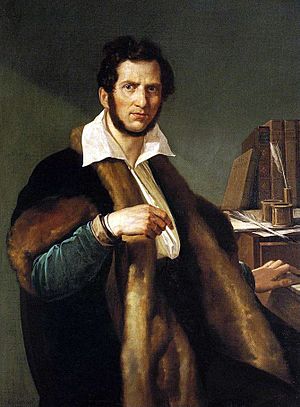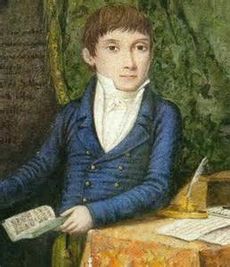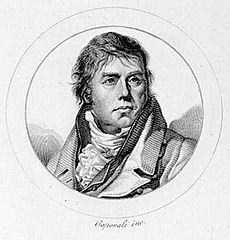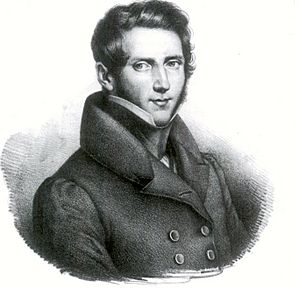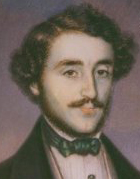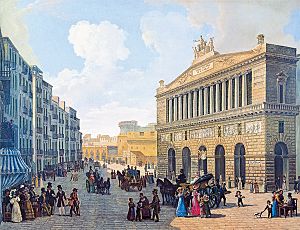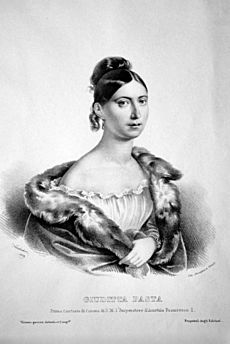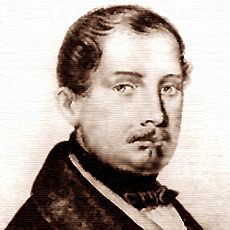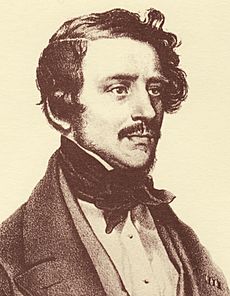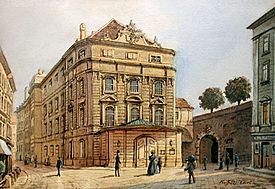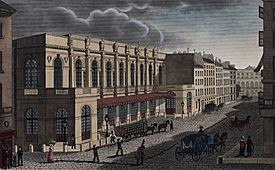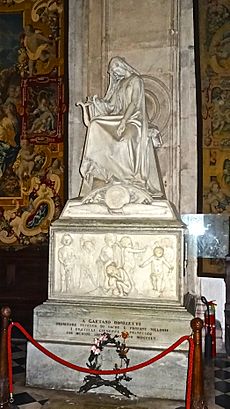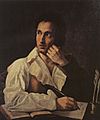Gaetano Donizetti facts for kids
Domenico Gaetano Maria Donizetti (born November 29, 1797 – died April 8, 1848) was a famous Italian composer. He is best known for writing almost 70 operas. Donizetti was one of the most important composers of the bel canto (beautiful singing) opera style in the early 1800s. Other famous composers like Gioachino Rossini and Vincenzo Bellini were also part of this style. Donizetti's music likely influenced later composers like Giuseppe Verdi.
Donizetti was born in Bergamo, Italy. When he was young, a kind teacher named Simon Mayr helped him get a scholarship to a music school. There, Donizetti learned a lot about music. Mayr also helped him get into the Bologna Academy, where Donizetti wrote his first short opera, Il Pigmalione, when he was only 19.
In 1822, Donizetti moved to Naples after getting an offer from a theater manager named Domenico Barbaja. He lived in Naples for many years, and 51 of his operas were performed there. At first, his funny operas (called comic operas) were more popular. His first big success with a serious opera (called opera seria) was Zoraida di Granata in 1822.
A very important moment came in 1830 with his opera Anna Bolena. This opera made a huge impact on the opera world and showed that Donizetti was a master of serious opera. Even after this, he still wrote popular comedies like L'elisir d'amore (1832) and Don Pasquale (1843). Some of his most famous serious operas include Lucia di Lammermoor (1835) and Roberto Devereux (1837).
Donizetti felt limited by the rules in Italy, especially in Naples, where the government censored what could be shown on stage. Around 1836, he became interested in working in Paris, France, where he felt he would have more freedom and earn more money. From 1838, he spent a lot of time in Paris, writing operas with French words and helping to stage his Italian works. His health began to decline around 1843. By 1846, he needed special care, and in 1847, friends helped him move back to Bergamo, where he passed away in April 1848.
Contents
Early Life and Musical Training
Gaetano Donizetti was the youngest of three sons. He was born in 1797 in a poor part of Bergamo. His family was not musical; his father worked at a pawnshop.
In 1805, a German composer named Simon Mayr started a music school in Bergamo. In 1807, Gaetano, who was nine, was accepted into the school. Mayr quickly saw that Gaetano was very talented. He reported that Gaetano "surpasses all the others in musical progress." Mayr made sure that young Gaetano could continue his studies, even when his voice changed.
Donizetti stayed at Mayr's school for nine years, until 1815. Mayr was like a second father to him. He even wrote a small play where Donizetti played "the little composer" to show off his talent.
Even though Donizetti sometimes skipped classes, Mayr believed in him. He helped Donizetti get scholarships and letters of recommendation to study in Bologna. In Bologna, Donizetti studied with a famous teacher named Padre Stanislao Mattei. Donizetti worked hard and proved Mayr's faith in him was well-placed.
Becoming an Opera Composer
First Steps in Opera (1818–1822)
After his studies, Donizetti returned to Bergamo. He met an old school friend, Bartolomeo Merelli, who offered him a chance to write an opera. Donizetti wrote the music for Enrico di Borgogna without a theater asking for it first. He then found a theater in Venice that would perform it in November 1818. The opera had some problems, but the audience still liked Donizetti's music.
This led to another short opera, Una follia. However, Donizetti didn't get much more work right away. He went back to Bergamo and wrote some church music and instrumental pieces. He also wrote Il falegname di Livonia in 1819.
Success in Rome and Naples (1822–1830)
Donizetti wanted to make a bigger name for himself. He knew that to succeed, he needed to write music that audiences loved, similar to the popular style of Gioachino Rossini.
In 1821, he got a contract to write an opera for the Teatro Argentina in Rome. This serious opera was Zoraida di Granata. It opened in January 1822. Even though the main singer got sick, the opera was a success.
The success of Zoraida impressed Domenico Barbaja, a powerful theater manager in Naples. Barbaja offered Donizetti a contract to write new operas and help with other productions. Donizetti moved to Naples and stayed there for many years. His first opera in Naples, La zingara, was a big hit in May 1822. It ran for many nights and was highly praised.
Donizetti also worked with important writers for his operas, like Felice Romani and Jacopo Ferretti. In 1824, his funny opera L'ajo nell'imbarazzo (The Tutor Embarrassed) was a huge success in Rome. This opera showed that Donizetti was very good at creating dramatic and engaging music.
From 1825 to 1827, Donizetti worked in Palermo for a year, then returned to Naples. He met the writer Domenico Gilardoni, who wrote many opera stories for him. Donizetti was also hired to write twelve new operas for Naples and became the Director of the Royal Theatres of Naples in 1829. This was a very important job. In 1828, he married Virginia Vasselli.
International Fame (1830–1838)
In 1830, Donizetti achieved his first major international success with Anna Bolena. This opera premiered in Milan with the famous singer Giuditta Pasta in the main role. Anna Bolena made Donizetti famous across Europe. It was performed in many cities for years.
After Anna Bolena, Donizetti wrote many more operas. One of his most beloved comedies, L'elisir d'amore (The Elixir of Love), came out in 1832. It is still considered a masterpiece of funny opera.
In 1835, Donizetti wrote Lucia di Lammermoor, based on a novel by Walter Scott. This opera became his most famous work and is a highlight of the bel canto style. It was a huge success, especially because other great Italian composers like Rossini had retired and Bellini had passed away. This left Donizetti as the leading Italian opera composer.
Donizetti also wrote a series of operas about English history, often called the "Three Donizetti Queens." These included Anna Bolena, Maria Stuarda (Mary Stuart), and Roberto Devereux. These operas explored the lives of famous historical figures like Henry VIII and Elizabeth I.
As his fame grew, Donizetti received offers from major opera houses, including the Paris Opera. He was the first Italian composer to be asked to write a grand opera for Paris.
Moving to Paris (1838–1840)
In 1838, Donizetti moved to Paris. He had a disagreement with the King of Naples, who banned his opera Poliuto because its religious story was considered unsuitable for the stage. In Paris, Donizetti rewrote Poliuto with a new, longer French story, and it became Les Martyrs. This was his first "grand opera" in the French style and was very successful.
Before leaving Paris in 1840, he also wrote La fille du régiment (The Daughter of the Regiment), his first opera written entirely in French. This opera also became a big hit.
Traveling and Composing (1840–1843)
After 1840, Donizetti traveled a lot between Paris, Milan, Vienna, and Naples. He continued to compose many new operas. In 1840, he adapted an unfinished opera into La favorite, which premiered in Paris. He also started Rita, though it wasn't performed until much later.
In 1842, Donizetti went to Vienna, where his opera Linda di Chamounix was a huge success. He was also given an important job as the music director for the royal court in Vienna, a position once held by Wolfgang Amadeus Mozart.
While in Bologna, Donizetti met Rossini for the first time. Rossini praised Donizetti's conducting skills.
In late 1842, Donizetti returned to Paris. He was asked to write a new funny opera for the Théâtre-Italien. This became Don Pasquale, which premiered in January 1843 and was an enormous success. It is still one of his most popular operas today.
Declining Health and Final Years (1843–1848)
By 1843, Donizetti's health began to seriously decline. He suffered from severe headaches and other problems, which made it hard for him to concentrate. Despite this, he continued to compose as much as he could. He wrote to friends about his "new illness" and how tired he felt.
He continued to travel between cities, fulfilling his commitments. In Vienna, he oversaw productions of his own operas and even conducted Verdi's Ernani, which Verdi greatly appreciated.
In Paris, he worked on his longest opera, Dom Sébastien, roi de Portugal, which was a massive project. He also prepared Maria di Rohan for performance. Both were successful.
By 1844, friends noticed a worrying change in Donizetti's physical condition. He often had trouble standing and concentrating. He tried to reduce his work, but his health continued to worsen.
In August 1845, doctors diagnosed Donizetti with a severe mental illness. They recommended he stop working and move to a warmer climate. His nephew, Andrea Donizetti, came from Constantinople to care for him.
In February 1846, Donizetti was taken to a special facility outside Paris where he could receive care. He believed he was traveling to Vienna. Friends who visited him said he was treated well. Andrea tried to move his uncle back to Italy, but the police initially prevented it due to concerns about his health during travel.
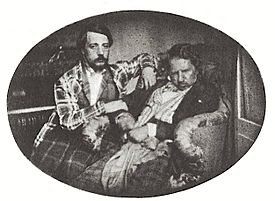
After much effort and help from the Austrian Embassy, Donizetti was finally allowed to leave Paris in October 1847. He began a seventeen-day journey back to Bergamo, Italy.
He arrived in Bergamo on October 6, 1847, and stayed in a palace belonging to the noble Scotti family. He was very weak and rarely spoke. When people played music from his operas, he sometimes seemed to listen, but he didn't always recognize visitors. His condition continued to decline, and he passed away on April 8, 1848.
Donizetti was first buried in a local cemetery, but in 1875, his body was moved to the Basilica of Santa Maria Maggiore in Bergamo, near the grave of his beloved teacher, Simon Mayr.
Personal Life
During his time in Rome, Donizetti met the Vasselli family and became good friends with Antonio Vasselli. Antonio's sister, Virginia, became Donizetti's wife in 1828. Sadly, all three of their children died very young. Virginia herself passed away in 1837, possibly from cholera or measles, which was a great sorrow for Donizetti.
Gaetano was the younger brother of Giuseppe Donizetti, who became a music instructor at the court of the Sultan in the Ottoman Empire. His youngest brother, Francesco, lived his whole life in Bergamo and passed away shortly after Gaetano.
Donizetti's Compositions
Donizetti was a very busy composer. He wrote not only operas but also church music, string quartets, and orchestral pieces. He composed about 75 operas, along with many symphonies, songs, duets, and other musical works.
| Operas (see List of operas by Gaetano Donizetti) | |||||||
|---|---|---|---|---|---|---|---|
| Choral works | |||||||
| Ave Maria | Grande Offertorio | Il sospiro | Messa da Requiem | Messa di Gloria e Credo | Miserere (Psalm 50) | ||
| Orchestral works | |||||||
| Allegro for Strings in C major | Larghetto, tema e variazioni in E flat major | Sinfonia Concertante in D major (1817) | Sinfonia in A major | Sinfonia in C major | Sinfonia in D major (1818) | Sinfonia in D minor | |
| Concertos | |||||||
| Concertino for Clarinet in B flat major | Concertino for English Horn in G major (1816) | Concertino in C minor for flute and chamber orchestra (1819) | Concertino for Flute and Orchestra in C major | Concertino for Flute and Orchestra in D major | Concertino for Oboe in F major | Concertino for Violin and Cello in D minor | Concerto for Violin and Cello in D minor |
| Concerto for 2 Clarinets "Maria Padilla" | |||||||
| Chamber works | |||||||
| Andante sostenuto for Oboe and Harp in F minor | Introduction for Strings in D major | Larghetto and Allegro for Violin and Harp in G minor | Largo/Moderato for Cello and Piano in G minor | Nocturnes (4) for Winds and Strings | Sonata for Flute and Harp | Sonata for Flute and Piano in C major | |
| Sinfonia for Winds in G minor (1817) | Quintet for Guitar and Strings no 2 in C major | Study for Clarinet no 1 in B flat major | Trio for Flute, Bassoon and Piano in F major | ||||
| Quartets for strings | |||||||
| String Quartet in D major | No. 3 in C minor: 2nd movement, Adagio ma non troppo | No. 4 in D major | No. 5 in E minor | No. 5 in E minor: Larghetto | No. 6 in G minor | No. 7 in F minor | No. 8 in B flat major |
| No. 9 in D minor | No. 11 in C major | No. 12 in C major | No. 13 in A major | No. 14 in D major | No. 15 in F major | No. 16 in B minor | No 17 in D major |
| No. 18 in E minor | No. 18 in E minor: Allegro | ||||||
| Piano works | |||||||
| Adagio and Allegro in G major | Allegro in C major | Allegro in F minor | Fugue in G minor | Grand Waltz in A major | Larghetto in A minor "Una furtiva lagrima" | Larghetto in C major | Pastorale in E major |
| Presto in F minor | Sinfonia in A major | Sinfonia No. 1 in C major | Sinfonia No. 1 in D major | Sinfonia No. 2 in C major | Sinfonia No. 2 in D major | Sonata in C major | Sonata in F major |
| Sonata in G major | Variations in E major | Variations in G major | Waltz in A major | Waltz in C major | Waltz in C major "The Invitation" | ||
Images for kids
See also
 In Spanish: Gaetano Donizetti para niños
In Spanish: Gaetano Donizetti para niños


